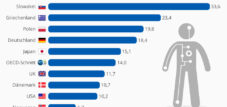According to the UK Office of National Statistics, 1.5 million jobs in England are at risk from automation. The ONS defines automation as tasks currently performed by employees that are replaced by technology. It found that waitresses and waiters are most at risk from automation, followed by shelf stockers and people in simple sales jobs.
Medical professionals have the lowest risk from automation, followed by teachers in higher education and senior professionals in educational institutions. The ONS also said 70 per cent of roles at risk of high automation are currently held by women, while people in part-time jobs and young people are most at risk.
According to the UK's Office of National Statistics , 1.5 million jobs in England are at risk from automation. The ONS defines automation as tasks currently carried out by workers being replaced with technology. It found that waiters and waitresses are at the highest risk from automation, followed by shelf fillers and people in elementary sales occupations.
Medical practitioners have the lowest level of risk from automation, followed by teachers in higher education and senior professionals of educational establishments. The ONS also said that 70 percent of the roles at risk of high automation are currently held by women while people in part-time jobs and the young are the next most at risk.


